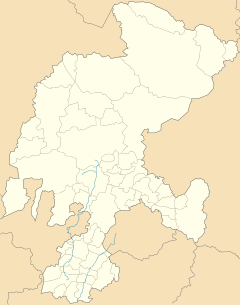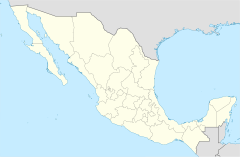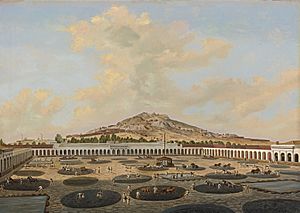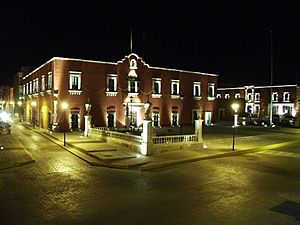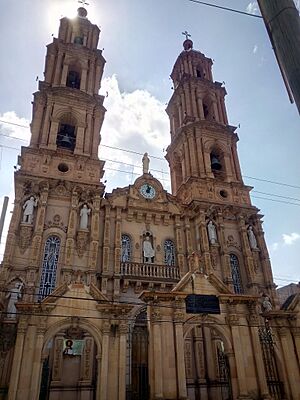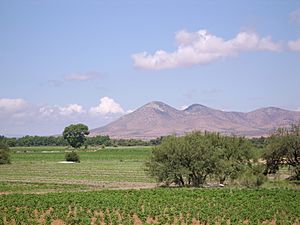Fresnillo facts for kids
Quick facts for kids
Fresnillo, Zacatecas
|
|
|---|---|
| Fresnillo de González Echeverría | |
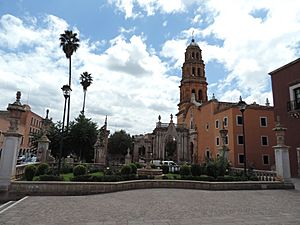
Templo de la Purificación in Fresnillo
|
|
| Country | |
| State | Zacatecas |
| Municipality | Fresnillo |
| Founded | September 2, 1554 |
| Area | |
| • Municipality | 4,900 km2 (1,910 sq mi) |
| Elevation | 2,210 m (7,250 ft) |
| Population
(2020)
|
|
| • Total | 143,281 |
| • Density | 47,12/km2 (12,200/sq mi) |
| • Demonym | Fresnillense |
| Time zone | UTC-6 (Central (US Central)) |
| • Summer (DST) | UTC-5 (Central) |
| Area code(s) | 493 |
| Website | Official website: http://www.fresnillo.gob.mx |
Fresnillo is a city in central Mexico. It was founded a long time ago, in 1554, by Francisco de Ibarra. It is the second largest city in the state of Zacatecas. Fresnillo is a busy place where roads and railways meet.
The city is famous for its rich mining areas, especially for silver. One of the world's richest silver mines, the Fresnillo Mine (also called Mina Proaño), is located here. Besides mining, people in Fresnillo also work in farming, growing crops like cereals and beans. They also raise cattle. There is even a special school for mining here.
Many people visit Fresnillo for religious journeys. They come to see the famous Santo Niño de Atocha ("Holy Child of Atocha"). This is a special Roman Catholic statue that came to Mexico from Spain.
Contents
History of Fresnillo
Early Explorations and Founding
Between 1551 and 1552, a person named Diego Fernández de Proaño explored the Zacatecas area. He was looking for a special hill said to have lots of valuable minerals. He found a hill that seemed rich in minerals. He called it "Cerro de Proaño," which means "Proaño's Hill." However, his discovery was forgotten for a while.
Later, on September 2, 1554, a 15-year-old explorer named Francisco de Ibarra arrived at a new spot. He found a fresh water spring with a small ash tree nearby. He decided to stay the night. In his journal, he named the place "Ojo de Agua del Fresnillo," meaning "spring of the small ash." This is how Fresnillo got its name.
Challenges and Growth
In its early years, the town faced attacks from the Guachichil Indians. These were nomadic groups who moved around a lot. Because the settlers lost many people, the leader of the area, Martín Enríquez de Almanza, ordered a fort to be built. This fort was built where the city hall stands today.
For many years, between 1682 and 1757, the mines in Fresnillo were very active. Most of these mines were on the sides of Proaño's Hill. But around 1757, the mines became very deep, about fifty meters. Water started to flood them, making it too expensive to keep mining. So, the mines were closed, and the area faced tough economic times.
Geography and Climate
Fresnillo is located in a high area of Mexico. Knowing about the weather helps us understand what life is like there.
Fresnillo's Weather Patterns
The climate in Fresnillo is shown in the table below. It gives details about temperatures and rainfall throughout the year.
| Climate data for Fresnillo | |||||||||||||
|---|---|---|---|---|---|---|---|---|---|---|---|---|---|
| Month | Jan | Feb | Mar | Apr | May | Jun | Jul | Aug | Sep | Oct | Nov | Dec | Year |
| Record high °C (°F) | 31.0 (87.8) |
30.0 (86.0) |
33.0 (91.4) |
39.0 (102.2) |
38.0 (100.4) |
38.5 (101.3) |
34.0 (93.2) |
34.0 (93.2) |
33.0 (91.4) |
33.0 (91.4) |
31.0 (87.8) |
29.0 (84.2) |
39.0 (102.2) |
| Mean daily maximum °C (°F) | 19.9 (67.8) |
21.9 (71.4) |
24.7 (76.5) |
26.8 (80.2) |
29.4 (84.9) |
28.5 (83.3) |
26.0 (78.8) |
25.5 (77.9) |
24.7 (76.5) |
24.4 (75.9) |
22.7 (72.9) |
20.4 (68.7) |
24.6 (76.3) |
| Daily mean °C (°F) | 12.1 (53.8) |
13.5 (56.3) |
16.2 (61.2) |
18.3 (64.9) |
21.1 (70.0) |
21.2 (70.2) |
19.6 (67.3) |
19.3 (66.7) |
18.5 (65.3) |
17.2 (63.0) |
14.8 (58.6) |
12.8 (55.0) |
17.1 (62.8) |
| Mean daily minimum °C (°F) | 4.3 (39.7) |
5.1 (41.2) |
7.6 (45.7) |
9.8 (49.6) |
12.9 (55.2) |
13.9 (57.0) |
13.1 (55.6) |
13.0 (55.4) |
12.3 (54.1) |
10.1 (50.2) |
6.9 (44.4) |
5.1 (41.2) |
9.5 (49.1) |
| Record low °C (°F) | −5.5 (22.1) |
−7.0 (19.4) |
−2.0 (28.4) |
0.0 (32.0) |
4.0 (39.2) |
4.5 (40.1) |
7.0 (44.6) |
7.0 (44.6) |
4.0 (39.2) |
1.0 (33.8) |
−3.0 (26.6) |
−10.5 (13.1) |
−10.5 (13.1) |
| Average precipitation mm (inches) | 15.6 (0.61) |
5.2 (0.20) |
1.2 (0.05) |
3.4 (0.13) |
17.4 (0.69) |
74.5 (2.93) |
87.0 (3.43) |
96.5 (3.80) |
60.6 (2.39) |
32.9 (1.30) |
12.4 (0.49) |
12.3 (0.48) |
419.0 (16.50) |
| Average precipitation days (≥ 0.1 mm) | 2.4 | 1.0 | 0.8 | 1.0 | 3.6 | 8.8 | 10.7 | 11.9 | 9.2 | 5.2 | 2.0 | 2.7 | 59.3 |
| Source: Servicio Meteorologico Nacional | |||||||||||||
The Coat of Arms of Fresnillo
The coat of arms is like a special symbol for the city. At the top, it has a Latin phrase that means: "Since its Founding a City that Works and Prays." At the bottom, it says "Royal Mine of Fresnillo." In the middle, a bar shows the date: "September 2, 1554."
The shield is split into three parts. On the top left, you can see the Virgin of Candlemas. She is the protector of Fresnillo and holds a candle. On the top right, there is a shield and weapons used by both native people and Spaniards long ago. The bottom part shows a spring with an Ash tree next to it. It also shows the bottom of Proaño Hill with clouds, which reminds us of the rainy month of September.
Plateros: A Place of Faith
Fresnillo is often linked to Plateros, a nearby mining town. Many religious people visit Plateros. A church was built there in the late 1690s. It was built to remember a special silver crucifix that miners found. People say this crucifix appeared in a wooden box without anyone knowing how it was made.
Because of this special crucifix, a statue of the Our Lady of Atocha was brought from Spain. This statue shows the Virgin Mary holding baby Jesus. The baby Jesus statue became known as the Holy Child of Atocha.
Many people believe that praying to the Holy Child can lead to miracles. Those who feel the Holy Child has helped them often bring a gift to show their thanks. In 1883, a separate building was built just to hold all these gifts.
Today, many families travel far to visit this shrine. They attend church services and show their devotion. The Holy Child is seen as an important symbol for Zacatecas and a protector of miners.
Agriculture in Fresnillo
Farming is very important in Fresnillo. The city grows many different crops. These include corn, pepper, and tomatoes. Nearby towns and villages send their crops to Fresnillo and other places. The city's economy relies a lot on its successful farming, along with its silver mining.
See also
 In Spanish: Fresnillo para niños
In Spanish: Fresnillo para niños


